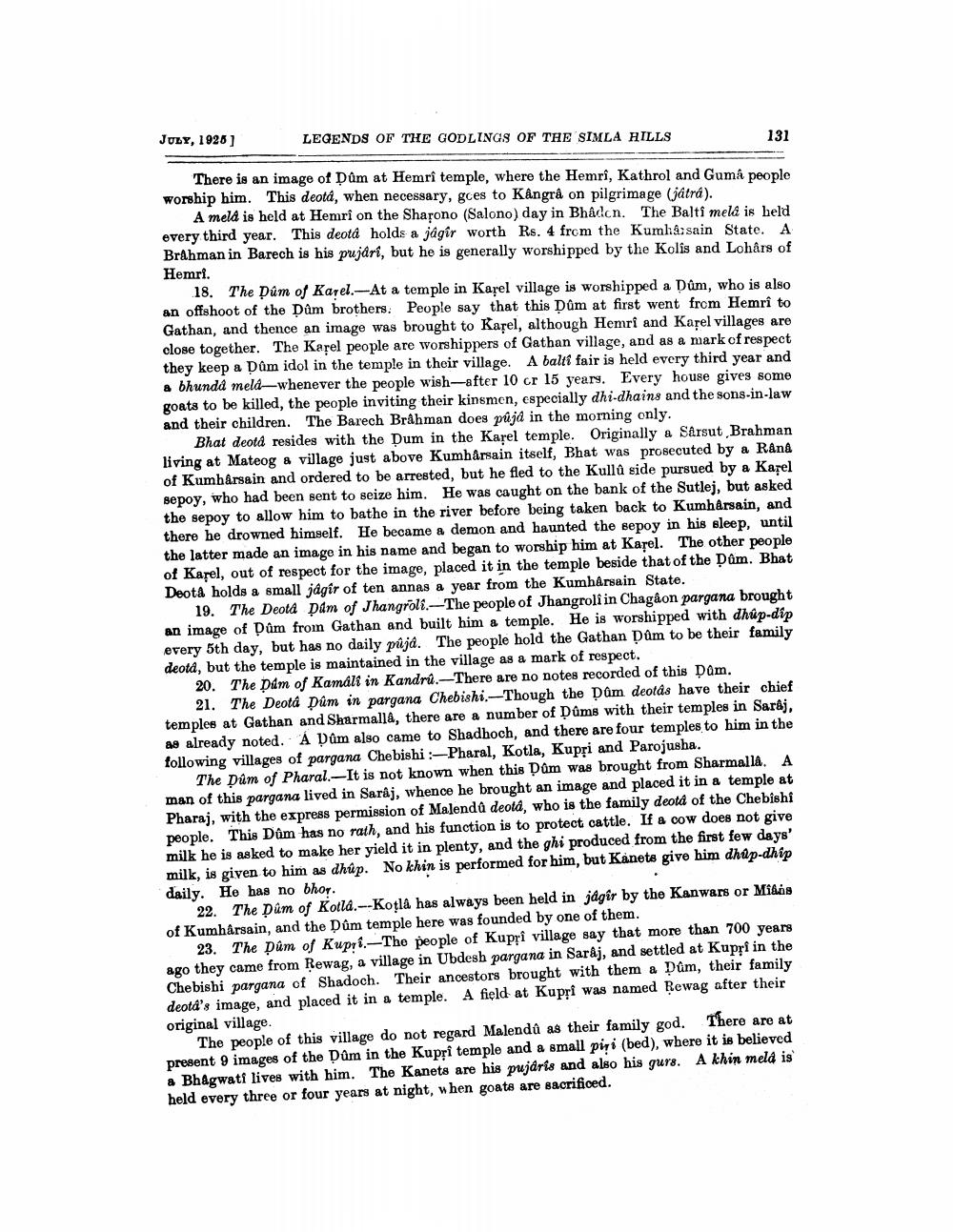________________
JULY, 1928] LEGENDS OF THE GODLINGS OF THE SIMLA HILLS
131 There is an image of Dům at Hemrî temple, where the Hemri, Kathrol and Gumà people worship him. This deota, when necessary, goes to Kangrâ on pilgrimage (játrá).
A meld is held at Hemri on the Sharono (Salono) day in Bhadon. The Balti meld is held every third year. This deotá holds a jágir worth Rs. 4 from the Kuml&rsain State. A Brahman in Barech is his pujari, but he is generally worshipped by the Kolis and Lohars of Hemri.
18. The Dům of Karel.-At a temple in Karel village is worshipped a Dům, who is also an offshoot of the Dům brothers. People say that this Dům at first went from Hemrî to Gathan, and thence an image was brought to Karel, although Hemri and Karel villages are close together. The Karel people are worshippers of Gathan village, and as a mark of respect they keep a Dům idol in the temple in their village. A balti fair is held every third year and a bhundd meld—whenever the people wish-after 10 cr 15 years. Every house gives some goats to be killed, the people inviting their kinsmen, especially dhi-dhains and the sons-in-law and their children. The Barech Brahman does půjd in the morning only.
Bhat deotá resides with the Dum in the Karel temple. Originally a Sarsut Brahman living at Mateog & village just above Kumhårsain itself, Bhat was prosecuted by a Rana of Kumhârsain and ordered to be arrested, but he fled to the Kullû side pursued by a Karel sepoy, who had been sent to seize him. He was caught on the bank of the Sutlej, but asked the sepoy to allow him to bathe in the river before being taken back to Kumhârsain, and there he drowned himself. He became a demon and haunted the sepoy in his sleep, until the latter made an image in his name and began to worship him at Kapel. The other people of Karel, out of respect for the image, placed it in the temple beside that of the Dâm. Bhat Deota holds a small jagir of ten annas a year from the Kumharsain State.
19. The Deota pam of Jhangroli.-The people of Jhangrolî in Chagaon pargana brought an image of Dům from Gathan and built him a temple. He is worshipped with dhúp-dip every 5th day, but has no daily půjd. The people hold the Gathan Dům to be their family deotd, but the temple is maintained in the village as a mark of respect.
20. The Dam of Kamált in Kandrú.-There are no notes recorded of this Dom.
21. The Deotá Dům in pargana Chebishi.-Though the Dům deotds have their chief temples at Gathan and Sharmall&, there are a number of Důms with their temples in Saraj, as already noted. A Dum also came to Shadhoch, and there are four temples to him in the following villages of pargana Chebishi - Pharal, Kotla, Kupri and Parojusha.
The Dům of Pharal.-It is not known when this Dum was brought from Sharmalla. A man of this pargana lived in Saraj, whence he brought an image and placed it in a temple at Pharaj, with the express permission of Malendû deotd, who is the family deota of the Chebishi people. This Dôm has no rath, and his function is to protect cattle. If a cow does not give milk he is asked to make her yield it in plenty, and the ghi produced from the first few days' milk, is given to him as dhúp. No khin is performed for him, but Kanets give him dhip-dhip daily. He has no bhor.
22. The Dům of Kotla.--Kotla has always been held in jdgir by the Kanwars or Mias of Kumhârsain, and the Dům temple here was founded by one of them.
23. The Dům of Kupri.-The people of Kupri village say that more than 700 years ago they came from Rewag, a village in Ubdesh pargana in Saraj, and settled at Kupri in the Che bishi pargana of Shadoch. Their ancestors brought with them a Dům, their family deotá's image, and placed it in a temple. A field at Kupri was named Rewag after their original village.
The people of this village do not regard Malendû as their family god. There are at present 9 images of the Dum in the Kupri temple and a small piri (bed), where it is believed
Bhagwati lives with him. The Kanets are his pujdris and also his gurs. A khin meld is held every three or four years at night, when goats are sacrificed.




